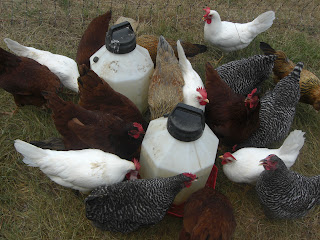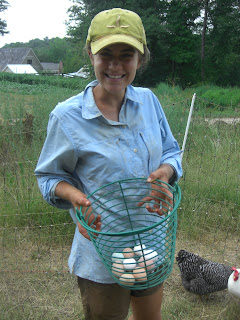I had always thought a majority of farmers were old men who wore overalls, and who were grumpy from the long hours of labor under the sun, coupled with being isolated in the rural boondocks. That was a huge misconception I had. Thus began my conquest in search for answers. Answers that would put an end to my narrow view of farmers. So I decided to interview Maya, one of the apprentices at Serenbe Farms.
Julie (interviewer)
Maya (interviewee)
J: How long have you been working on a farm?
M: March 2011
J: What made you interested in joining the crew at Serenbe Farms?
M: In the summer of 2011, I volunteered on a farm on the weekends in Pennsylvania. I enjoyed it a lot and I became interested in getting a job out of it, so I sought out Serenbe Farms.
J: How has your experience been so far?
M: It's been great! I've learned a lot about farming and I want to pursue it as a career. Since I'm from Atlanta, I feel so connected to the growing organic community in Georgia. Plus, I just love everything that goes into running a farm.
J: What is one thing you have learned here at Serenbe that you did not know prior to working here.
M: Cover cropping. I didn't know what it was. I thought you would either have bare land or be actively growing crops.
J: What is your favorite aspect of working at Serenbe?
M: Taking care of the plants/crops. I enjoy nursing a tiny seed and watching it grow into something that you can eat or is aesthetically pleasing. I find it rewarding in nurturing them and making sure they're healthy. Plus, I'm continuously learning about what you can do to make them thrive.
J: What vegetable describes you and why?
M: Tomatillo. It's my favorite and its uniqueness stands out to me!
Serenbe Farms Internship
Thursday, July 19, 2012
Tuesday, July 17, 2012
Cover Crops
Last Wednesday, we (the apprentices and I) were given an assignment to work on. We were each assigned a cover crop and had to give a mini presentation. Cover crops are utilized in between normal growing seasons. Examples include rye, oat, clovers, and legumes. These are planted in order to protect and improve soil quality. A few advantages of growing cover crops are that they:
- prevent weeds
- increase organic matter
- fix nitrogen
- decrease soil erosion, disease, and pests
Saturday, July 14, 2012
A Taste of the Happenings
Just wanted to show my experience thus far.
 |
| Maya & Kaitlin picking squash and zucchini. |
 |
| Such beautiful flowers among the squash patch! |
 |
| A bounty of zucchini and squash. We even found yellow zucchini! |
 |
| Chickens drinking water.. |
 |
| Christine collecting eggs. |
 |
| Long drip lines run through rows of the field to provide irrigation. |
 |
| Reliable truck that takes us to and fro across the farm. |
 |
| Maya guiding Kenneth how to place conduits into the ground for the noodle beans to be trellised. |
Maintenance
 |
| Kaitlin weeding! |
For many, the first thing that comes to mind when one thinks of farming is usually planting or harvesting. Weeding is often overlooked and thought of as the chore/housework of farming,so I wanted to highlight the importance of this tedious, yet necessary task.
Weeds are a problem for many reasons: 1)they grow quickly 2)they can shade over crops 3)they compete for water and nutrients. Since weeds are known to grow quickly, they can become out of control if not managed. And like many of us know, plants need the essentials to grow--light, water, and nutrients. If they continue to grow without being uprooted, they can grow tall preventing light from reaching the crops you plan to harvest as well as smothering them.
At Serenbe, there are several fields, so you can never get enough of weeding! Plus, it's best to make weeding a weekly routine. Some weeds have an extensive underground root system, so neglecting them will just make it harder to uproot them later.
See if you can spot the difference!
Before
After
Kudzu Critters
Twice I've encountered these flying beetles on the farm while working with both green beans and soybeans. Kudzus are notorious for flying and sticking to whatever area they desire, particularly soybeans. We've become so familiar with kudzus in the South for the past three years ever since they were introduced to America from Japan as an invasive species. Kudzus have become such a problem because they have been attacking soybean plants by eating at the stems and leaves. And I have no doubt that's exactly what they were doing to the edamame plants we had recently harvested at Serenbe. There were hundreds of Kudzu bugs swarming and attaching themselves to us while we prepped the soybeans. Now, little did I know about Kudzu bugs the day we did this. Apparently, these critters kept invading and landing on my orange hat. Later, I discovered that Kudzus are attracted to light colored objects such as white cars. In addition, every once in a while I would swat off a couple of bugs on my neck and chest. I was unfortunate enough to be a victim to their "bug spray". Within a matter of time, I felt a burning sensation on my neck and chest. Kudzu bugs are from the stinkbug family and thus release a chemical when they feel threatened as a part of their defense mechanism. This secretion is no regular irritant, it's pretty potent and leaves a scar. Be sure to wear long sleeves and pants while in the presence of these beetles!
 |
 |
| Attracted to bright colors! |
 |
| crawling on my arm. Luckily no burns afflicted here |
 |
| So many attached to the edamame that we had to shake them off |
Subscribe to:
Posts (Atom)




